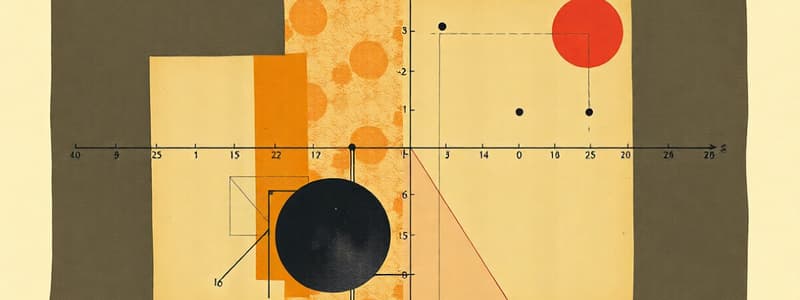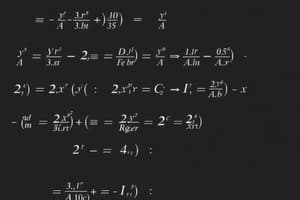Podcast
Questions and Answers
Which of the following functions is increasing everywhere?
Which of the following functions is increasing everywhere?
- y = 3x^2 (correct)
- y = -2x
- y = x^3 + x (correct)
- y = x^3 - 2x
What is the global minimum of the function y = x^2 + 1?
What is the global minimum of the function y = x^2 + 1?
1
The function y = |x| has a global minimum at x = 0.
The function y = |x| has a global minimum at x = 0.
True (A)
At which points does the function y = x^3 - 2x have a local maximum?
At which points does the function y = x^3 - 2x have a local maximum?
The general form of a linear function is f(x) = ___ + b.
The general form of a linear function is f(x) = ___ + b.
For the function y = 4x + b, if f(1) = 1, what must b be?
For the function y = 4x + b, if f(1) = 1, what must b be?
Decreasing functions include ___ and marginal utility.
Decreasing functions include ___ and marginal utility.
What defines the domain of the most common functions students come up with?
What defines the domain of the most common functions students come up with?
Which function is decreasing everywhere?
Which function is decreasing everywhere?
Flashcards are hidden until you start studying
Study Notes
Chapter 2: One-Variable Calculus: Foundations
- Describes different types of functions including increasing, decreasing, and those with local/global maxima and minima.
- Example functions:
- y = 3x^2 + 2, increasing everywhere (no local maxima or minima).
- y = -2x, decreasing everywhere (no local maxima or minima).
- y = x^2 + 1, global minimum of 1 at x = 0 (decreasing on (-∞, 0) and increasing on (0, ∞)).
- y = x^3 + x, increasing everywhere (no local maxima or minima).
- y = x^3 - 2x, local maximum of 2√(6)/3 at -√(6)/3, local minimum of -2√(6)/3 at √(6)/3 (no global maxima or minima).
- y = |x|, decreasing on (-∞, 0) and increasing on (0, ∞) (global minimum of 0 at x = 0).
- Increasing functions are used to represent economic concepts like production and supply.
- Decreasing functions are used to represent economic concepts like demand and marginal utility.
- Functions with global critical points are used to model average cost (with fixed costs) and profit functions.
- Examples of finding a function's formula given certain points and slope:
- If the slope (m) is 2 and y- intercept (b) is 3, the function is f(x) = 2x + 3.
- If the slope (m) is -3 and passes through the origin, the function is f(x) = -3x.
- Finding the y-intercept:
- If the slope (m) is 4 and passes through point (1, 1), then b = -3 and the function is f(x) = 4x - 3.
- If the slope (m) is 2 and passes through point (1, 3), then f(x) = 2x + 1.
- Finding x for various values of functions:
- If the function is f(x) = 2^x , then f(x) = 1 when x = 0, f(x) = -1 when x = -1, f(x) = 0 when x = -∞, and f(x) = 3 when x = log23 .
Studying That Suits You
Use AI to generate personalized quizzes and flashcards to suit your learning preferences.




